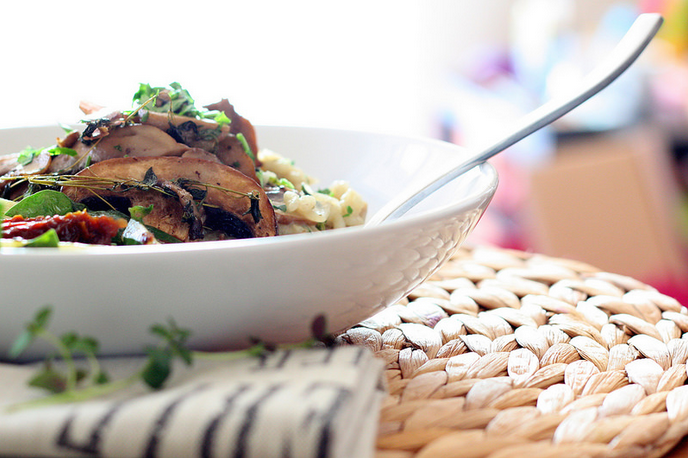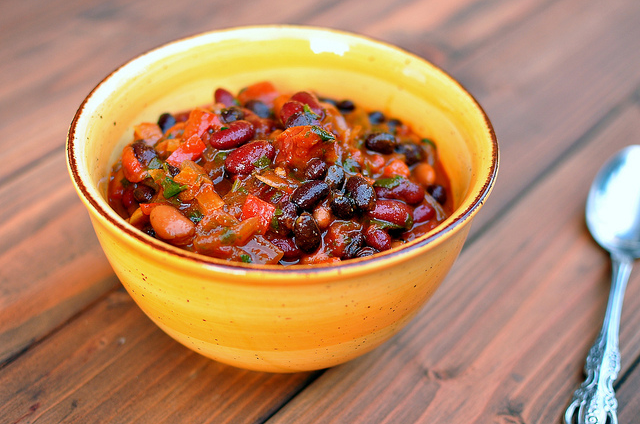Traditional vegetarian/vegan dishes are all about freshness and the perfect combination of spices. If you plan on having rice, salad, grilled vegetables, tofu, grilled squash or eggplant, you'll want to go with light and refreshing white grape varieties, such as an unwooded Saumur, a Muscadet or a Trebbiano. Salads come in all shapes and sizes; however, if you're in the mood for a quinoa salad, opt for a classic Carmen Chardonnay, or something a little funkier like a great Robertson Winery Chenin Blanc. Any and all grilled vegetable dishes will pair phenomenally with L'Orpailleur, a delicious Quebec white wine. Grilled Portobello mushrooms, or any mushrooms for that matter, are perfect with a woody white wine. The wild and somewhat woody aromas of the mushrooms will exquisitely complement those of the wine. With all things chili, choose a red Louis Roche Saumur Champigny. The wine's vegetable notes will impeccably reflect the flavors in the chili. Tomato-based dishes, such as bruschetta or again chili, require a light red wine. Go-to options include the Zenato Valpolicella Classico Superiore, the Canti Barbera d'Asti Superiore or the Beni di Batasiolo Langhe. Last but not least, the vege burger. You'll definitely want to go with a chardonnay from France's Burgundy region for this one. Although many varieties exist, the Albert Bichot Chardonnay Vielles Vignes will suit the flavors of the burger to a tee. Unfortunately, Montréal does not have any bring your own wine vegetarian/vegan restaurants, but you can definitely pick up some of these ingredients and stop by an SAQ to test out our suggestions with a home-cooked meal!
GLOSSARY
Aroma: Commonly used to describe the smell of a relatively young, unevolved wine. Ex: spicy, floral, fruit etc.
Floral: Red and white wines can have floral aromas.
Dry: Red or white wines that lost all residual sugar during fermentation. Somewhat subjective to what tasters perceive as sweet.
Fresh: Freshness is a good quality; it comes with acidity.
Balance: One of the most desired traits in a wine. When then concentration of fruit, level of tannins and acidity are in complete harmony.
Light: Red and white wines that contain minimal alcohol. Such a wine will also feel light in your mouth.
Bold: Having richness and intensity of flavor or aroma.
Acidity: All wines naturally contain acids, but they should always be in harmony with the fruit and other components. Sufficient acidity gives liveliness and crispness, and can preserve a wine's freshness.
Spicy: A wine with aromas reminiscent of spices such as clove, mint, cinnamon, or pepper.
Soft: Delicate wines with gentle fruit. They can also be low in acidity.
Vegetal: Red or white wines with a subtle vegetable garden smell.
Woody: Red or white wines with excessive aromas of wood. Common to wines aged overlong in cask or barrel. Opposite of unwooded.
Minerality: Wine's buzzword. It would be best described as the meeting point between dry and wet. Mineral wines generally have a slightly salty character and flavors of slate or wet stone. This aroma or flavor comes from grapes grown in intense, rocky, mineral-laden soils.
Velvety: Smooth and rich in texture.
Crisp: A wine giving the impression of freshness, usually with high acidity.
Lively: A wine giving the impression of freshness and vitality.
Fruity: Descriptive of unevolved, light wines in which the fruit is dominant. Refers to the aroma and/or flavor of the grape, as well as other fruits flavors, such as apple, blackcurrant, cherry, pear, citrus fruits, peach raspberry or strawberry.
Buttery: Richness and smoothness of a wine, somewhat akin to the oiliness and flavor of butter.
Jammy: Wines with great intensity of fruit from excellent ripeness. Very concentrated, flavorful wine.
Rich: Full flavor, body and aroma.
Sweet: Both red and white wines can be considered sweet. Indicates the presence of residual sugar, retained when the grape is not completely converted into alcohol.
Tannins: In a nutshell, tannins are what leave your mouth feeling dry once you've tasted an unevolved red wine. They come from the skin, the seeds and the stalks of grapes. They can also stem from the maturing process in oak barrels. Why don't white wines normally contain tannins, you ask? Well, the juice is left to macerate with the skin and seeds of the grapes, the parts that contain the tannins. This is not the case for white wines. Good tannins bring structure and balance, and are essential to red wines. They are also particularly important in the conservation of wine.


Leave a comment